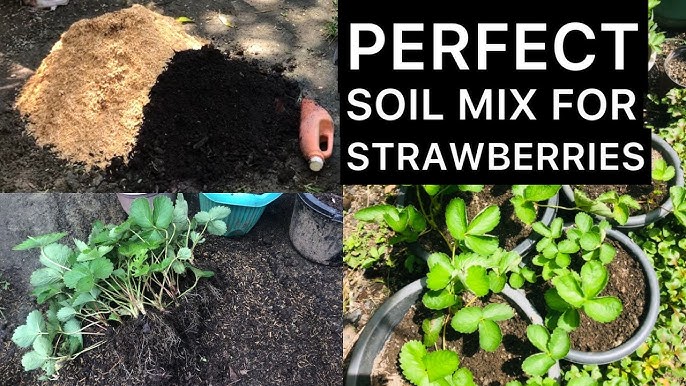Tips how to grow strawberries; Strawberries are one of the easiest and most rewarding fruits to grow at home. Whether you have a garden bed, a container, or a hanging basket, you can cultivate sweet, juicy berries with the right care. However, strawberries require proper soil, sunlight, and maintenance to thrive and produce a bountiful harvest. This guide provides 20 simple tips to help you grow delicious strawberries successfully.
1. Choosing the Right Strawberry Variety

There are three main types of strawberries: June-bearing, everbearing, and day-neutral. June-bearing strawberries produce one large crop per year, while everbearing varieties yield fruit twice a year. Day-neutral strawberries continuously produce smaller crops throughout the growing season. Choosing the right variety depends on your climate, space, and harvesting preferences.
If you want a large harvest all at once, June-bearing varieties like ‘Chandler’ or ‘Allstar’ are ideal. For a longer fruiting period, everbearing types such as ‘Ozark Beauty’ work well. Those looking for a steady supply of berries can opt for day-neutral varieties like ‘Albion’ or ‘Seascape.’ Researching local recommendations ensures you select the best strawberries for your region.
2. Picking the Perfect Location

Strawberries need at least six to eight hours of direct sunlight each day to produce sweet and abundant fruit. A sunny, well-ventilated spot helps prevent disease and ensures optimal plant growth. Avoid low-lying areas where water tends to collect, as excess moisture can lead to root rot. If space is limited, consider growing strawberries in raised beds or containers for better drainage.
When choosing a location, ensure it is protected from strong winds but still allows air circulation. Avoid planting strawberries near trees or large shrubs that can compete for nutrients and shade the plants. Sloped areas with good air movement help reduce fungal diseases, which thrive in damp conditions. A well-planned location maximizes your strawberry yield and prevents common growing issues.
3. Preparing the Soil

Strawberries thrive in slightly acidic soil with a pH between 5.5 and 6.5. Testing the soil before planting helps determine if amendments are needed to create the ideal growing conditions. Adding organic matter such as compost or aged manure improves soil fertility and drainage. Avoid heavy clay soils, which can retain too much moisture and suffocate the roots.
To further enhance soil quality, mix in peat moss or sand if drainage is poor. Raised beds filled with well-aerated, nutrient-rich soil can provide better growing conditions than compacted ground. Before planting, remove weeds and debris to prevent competition for nutrients. Healthy soil ensures strong root development and higher fruit production.
4. Planting at the Right Time
The best time to plant strawberries depends on your climate, but early spring is generally ideal. In warmer regions, fall planting allows the plants to establish roots before winter dormancy. Space the plants 12–18 inches apart in rows to ensure adequate airflow and reduce disease risk. Crowding the plants can lead to poor growth and smaller fruit yields.
When transplanting strawberry plants, handle the roots carefully to avoid damage. Ensure the crown (the central growing point) sits just above the soil level to prevent rot. If using bare-root plants, soak the roots in water for an hour before planting to hydrate them. Proper planting timing ensures strong establishment and a fruitful harvest.
5. Proper Planting Techniques

Correct planting depth is crucial for healthy strawberries. If planted too deep, the crown can rot, while shallow planting can expose roots to drying out. Dig a hole wide enough to spread the roots naturally, keeping the crown at soil level. Gently firm the soil around the roots to provide stability without compacting it too much.
Mulching around the plants with straw or pine needles helps retain moisture and suppress weeds. A two-inch layer of mulch also protects berries from touching the soil, preventing rot. Regularly inspect newly planted strawberries for signs of stress, such as wilting or yellowing leaves. Good planting techniques set the foundation for a thriving strawberry patch.
6. Watering Wisely
Strawberries need consistent moisture, especially during flowering and fruiting. Watering deeply once or twice a week encourages strong root development. Avoid shallow, frequent watering, as it can lead to weak plants and smaller berries. Using a drip irrigation system helps deliver water directly to the roots, reducing disease risk.
Morning watering is best, as it allows leaves to dry during the day, preventing fungal issues. Be careful not to overwater, as soggy soil can cause root rot. Mulching conserves moisture, reducing the need for frequent watering. Proper hydration ensures plump, juicy strawberries throughout the growing season.
7. Using Mulch for Healthier Plants
Mulching is essential for growing healthy strawberries because it helps retain moisture and regulate soil temperature. Straw, pine needles, or shredded leaves work well as organic mulches, preventing the berries from touching the soil and reducing rot. Mulch also suppresses weeds, which compete for nutrients and water. A layer of two to three inches of mulch is ideal for maintaining soil conditions and protecting plants.
In addition to moisture retention, mulch prevents soil-borne diseases by acting as a barrier between the plant and the ground. During winter, an extra layer of mulch insulates plants from freezing temperatures. In warmer seasons, it keeps the soil cool and prevents overheating. Regularly refreshing the mulch throughout the growing season ensures continued benefits.
8. Fertilizing for Maximum Growth
Strawberries need a balanced supply of nutrients to produce large, sweet fruit. Before planting, mix compost or a balanced fertilizer (such as 10-10-10) into the soil to provide essential nutrients. Once plants start growing, feed them with a nitrogen-rich fertilizer to promote healthy leaf and root development. During fruiting, switch to a phosphorus and potassium-rich fertilizer to enhance berry production.
Over-fertilizing can lead to excessive foliage growth at the expense of fruit production. Avoid applying fertilizer too late in the season, as this can encourage weak, frost-sensitive growth. Organic options like fish emulsion, compost tea, or aged manure provide slow-release nutrients. Proper fertilization ensures vigorous plants with an abundant harvest.
9. Controlling Weeds Naturally
Weeds compete with strawberries for water, nutrients, and sunlight, reducing plant productivity. Regular hand-weeding and using mulch help keep weeds under control. Planting ground cover crops, such as clover or low-growing herbs, can also suppress weed growth. Avoid using chemical herbicides, as they can damage strawberry plants and affect fruit quality.
Another effective strategy is to use landscape fabric beneath mulch to prevent weed seeds from sprouting. Maintaining clean rows between plants minimizes the spread of unwanted vegetation. Weeding after rain or watering makes it easier to pull out roots completely. A weed-free garden ensures healthier strawberries and higher yields.
10. Protecting Against Pests
Common strawberry pests include aphids, slugs, spider mites, and birds. Covering plants with bird netting prevents feathered thieves from stealing ripe berries. Natural predators like ladybugs and lacewings help control aphid populations. Sprinkling crushed eggshells or diatomaceous earth around plants deters slugs and snails.
Regularly inspecting plants for signs of pest damage allows for early intervention. Companion planting with marigolds, garlic, or onions can repel harmful insects. If infestations become severe, organic insecticidal soap or neem oil can help manage pests safely. A proactive approach keeps strawberries pest-free and thriving.
11. Preventing and Managing Diseases
Strawberries are susceptible to diseases like powdery mildew, gray mold, and root rot. Good air circulation, proper spacing, and avoiding overhead watering help prevent fungal infections. Rotating strawberry beds every three to four years reduces disease buildup in the soil. Removing infected leaves and fruit promptly prevents the spread of pathogens.
Applying an organic fungicide, such as a copper-based spray, can help protect plants if disease risk is high. Avoid planting strawberries in areas where tomatoes or potatoes were previously grown, as they share similar soil-borne diseases. Keeping the garden clean and free of debris minimizes fungal outbreaks. Healthy plants are more resistant to disease and produce better fruit.
12. Encouraging Pollination
Strawberry flowers rely on bees and other pollinators for fruit production. Planting bee-friendly flowers like lavender, borage, or clover nearby attracts beneficial insects. Avoid using chemical pesticides that can harm pollinators. If natural pollination is insufficient, gently shaking the flowers or using a small brush can help distribute pollen.
A diverse garden with various blooming plants ensures a steady presence of pollinators. Wind and insects play a crucial role in transferring pollen between flowers, leading to better fruit set. Encouraging biodiversity benefits not just strawberries but the entire garden ecosystem. Improved pollination results in larger, more uniform berries.
13. Pruning and Managing Runners
Strawberries send out runners, which are horizontal stems that produce new plants. While runners help expand a strawberry patch, they can also drain energy from the main plant. To maximize fruit production, remove excess runners so the plant focuses on developing berries. If you want to propagate more plants, select a few strong runners and allow them to root.
Regular pruning also helps improve air circulation and reduces disease risk. Trimming old leaves after harvest rejuvenates plants for the next growing season. Keeping plants neat and well-managed ensures higher-quality strawberries. Controlling runners prevents overcrowding and encourages stronger growth.
14. Growing Strawberries in Containers
Growing strawberries in containers is a great option for those with limited garden space. Choose pots or hanging baskets with good drainage to prevent waterlogging. A high-quality potting mix enriched with compost ensures adequate nutrients. Compact varieties like ‘Tristar’ and ‘Seascape’ perform well in containers.
Watering container-grown strawberries frequently is important since pots dry out faster than garden soil. Placing containers in a sunny location and rotating them ensures even growth. Fertilizing regularly with liquid compost tea or organic fertilizer keeps plants healthy. Container gardening allows for easy mobility and protection from pests.
15. Winterizing Your Strawberry Plants
In colder climates, protecting strawberry plants in winter prevents frost damage. Apply a thick layer of straw or pine mulch over the plants once the ground starts freezing. This insulation shields roots from extreme temperature fluctuations. Removing the mulch in early spring allows new growth to emerge.
For potted strawberries, moving containers to an unheated garage or basement prevents them from freezing. In mild climates, light mulch and occasional watering keep plants healthy. Covering strawberry beds with fabric row covers offers additional winter protection. Proper winter care ensures strong plants for the next growing season.
16. Harvesting at the Right Time
Strawberries are best picked when they are fully red and slightly soft. Harvesting in the morning preserves their freshness and flavor. Gently twist the berry off the stem instead of pulling to avoid damaging the plant. Picking regularly encourages more fruit production.
Overripe strawberries attract pests, so it’s essential to harvest on time. Leaving berries on the plant too long can reduce future yields. If you have excess ripe strawberries, refrigerate them immediately. Proper harvesting techniques ensure continuous fruiting and quality berries.
17. Storing and Preserving Your Harvest
Fresh strawberries have a short shelf life and should be consumed within a few days. Store them in the refrigerator unwashed, as moisture speeds up spoilage. For longer storage, freeze strawberries by spreading them in a single layer before transferring them to a bag. Dehydrating or making jams preserves their flavor for months.
Washing strawberries just before eating prevents mold growth. If freezing, removing the green tops beforehand makes them easier to use later. Strawberries can also be turned into sauces, syrups, or baked goods. Proper storage methods extend the enjoyment of your harvest.
18. Growing Strawberries Year-Round Indoors
Indoor strawberry gardening allows for fresh fruit throughout the year. Use grow lights to supplement natural sunlight if needed. Choose compact, everbearing varieties for continuous production. Hydroponic systems provide a space-efficient way to grow strawberries indoors.
Placing plants near a bright window ensures they receive enough light. Hand-pollination with a soft brush may be necessary for fruit set. Regular feeding with a liquid organic fertilizer supports steady growth. Indoor gardening brings the joy of fresh strawberries in any season.
19. Companion Planting for Healthier Strawberries
Companion planting enhances strawberry growth by repelling pests and improving soil health. Marigolds deter nematodes, while basil enhances flavor and growth. Avoid planting strawberries near cabbage or potatoes, which can attract harmful pests. Garlic and onions help protect against fungal diseases.
Strategic planting reduces the need for chemical pesticides. Herbs like thyme and oregano also contribute to a healthier growing environment. Combining strawberries with beneficial plants creates a natural, pest-resistant garden. Companion planting results in stronger plants and better yields.
20. Troubleshooting Common Problems
Even with proper care, strawberry plants can sometimes face issues like small, misshapen berries or yellowing leaves. Poor fruit development is often caused by a lack of pollination, overcrowding, or insufficient nutrients. Ensuring proper plant spacing, attracting pollinators, and applying balanced fertilizers can help improve fruit quality. Additionally, strawberries need consistent watering—drought stress can cause berries to remain small and dry.
Yellowing leaves may indicate overwatering, nutrient deficiencies, or fungal infections. If the lower leaves turn yellow while the rest of the plant remains healthy, nitrogen deficiency might be the cause. Applying compost or a balanced fertilizer can restore nutrient levels. Checking plants regularly for signs of stress or disease ensures quick intervention and better overall plant health.
Conclusion
By following these 20 simple tips, you can enjoy a successful strawberry harvest. Proper soil preparation, watering, pest control, and harvesting techniques all contribute to growing sweet, juicy berries. Whether in a garden bed or a container, strawberries thrive with care and attention. Start implementing these strategies today and enjoy fresh homegrown strawberries year after year!

